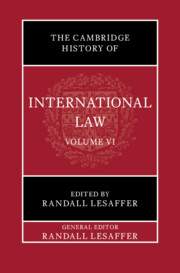Book contents
- The Cambridge History of International Law
- The Cambridge History of International Law
- Frontispiece
- The Cambridge History of International Law
- Copyright page
- Contents
- Plates
- Contributors
- Preface
- Abbreviations
- Part I International Law in Renaissance Europe (1492–1660)
- 1 The Law of Nations in Renaissance Europe
- 2 Territory and Jurisdiction in Renaissance Europe
- 3 Beyond the Free Sea
- 4 War and the Use of Force in Renaissance Europe
- 5 Warfare on Land in Renaissance Europe
- 6 The Law of Maritime Warfare during the Transition between Medieval and Early Modern Europe
- 7 Peacemaking in Renaissance Europe
- 8 Trade and Navigation in Renaissance Europe
- 9 Diplomacy in Renaissance Europe
- 10 Dispute Settlement in Renaissance Europe
- 11 The Ottoman Encounter and the Law of Nations in the Renaissance
- Part II International Law in Old Regime Europe (1660–1775)
- Index
- Plate Section (PDF Only)
- References
3 - Beyond the Free Sea
The Law of the Sea in Renaissance Europe
from Part I - International Law in Renaissance Europe (1492–1660)
Published online by Cambridge University Press: 22 April 2025
- The Cambridge History of International Law
- The Cambridge History of International Law
- Frontispiece
- The Cambridge History of International Law
- Copyright page
- Contents
- Plates
- Contributors
- Preface
- Abbreviations
- Part I International Law in Renaissance Europe (1492–1660)
- 1 The Law of Nations in Renaissance Europe
- 2 Territory and Jurisdiction in Renaissance Europe
- 3 Beyond the Free Sea
- 4 War and the Use of Force in Renaissance Europe
- 5 Warfare on Land in Renaissance Europe
- 6 The Law of Maritime Warfare during the Transition between Medieval and Early Modern Europe
- 7 Peacemaking in Renaissance Europe
- 8 Trade and Navigation in Renaissance Europe
- 9 Diplomacy in Renaissance Europe
- 10 Dispute Settlement in Renaissance Europe
- 11 The Ottoman Encounter and the Law of Nations in the Renaissance
- Part II International Law in Old Regime Europe (1660–1775)
- Index
- Plate Section (PDF Only)
- References
Summary
The question of whether or not the sea can be owned or controlled has occupied the minds of many over the centuries. The discovery of America by Columbus made the questions of ownership of the sea and how regimes to govern the sea could be created and managed gain importance on a global scale. This chapter discusses the history of the law of the sea from the perspective of ‘Renaissance Europe’, focusing on the ‘battle of the books’ dominated by the publication of Mare Liberum (1609) by Hugo de Groot (Grotius) and John Selden’s Mare clausum (1635). It shows that the concept of the free sea was perfectly compatible with the adjacent or territorial sea both in legal practice and in principle. The idea of the free sea, defended and made explicit by Grotius, was not new but originated in Roman law and its medieval interpretations. Rather than the free sea, mare clausum was the new contribution of early modern thinking on the law of the sea. The concept of mare clausum had been shaped by the division of the world’s oceans between Spain and Portugal based on the papal bull Inter Caetera (1493) and the treaties of Tordesillas (1494) and Zaragoza (1529).
- Type
- Chapter
- Information
- The Cambridge History of International Law , pp. 107 - 134Publisher: Cambridge University PressPrint publication year: 2025

